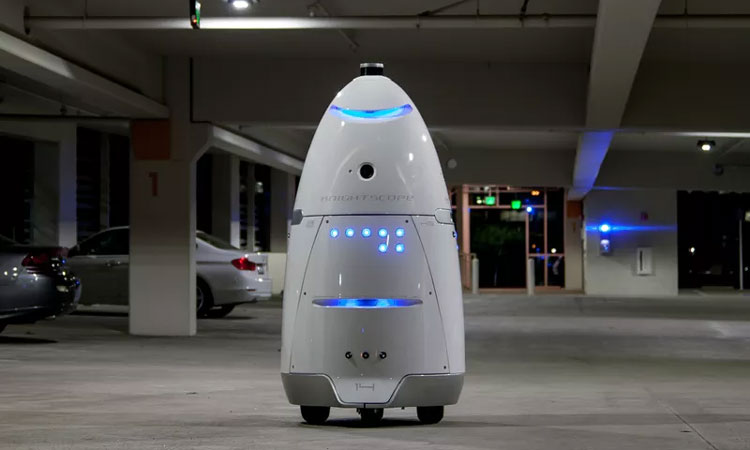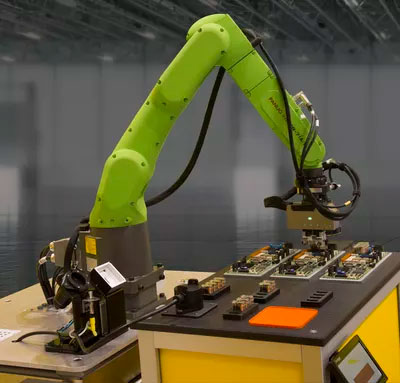In a talk at SXSW, roboticist Matt Rendall painted a picture of the future of robotic job displacement that focused less on automation and more on the realistic ways in which the robotics industry will reshape global manufacturing.
The takeaway was that America, which has outsourced much of its manufacturing and lacks serious investment in industrial robotics, may miss out on the world’s next radical shift in how goods are produced. That’s because the robot makers — as in, the robots that make the robots — could play a key role in determining how automation expands across the globe.
As the CEO of manufacturing robotics company Otto Motors (not to be confused with the self-driving trucking company Uber owns), Rendall focuses on building fleets of warehouse bots that could eventually replace the many fulfillment workers who are hired by companies like Amazon. His talk, titled “Robots vs Jobs: Technological Displacement is Here,” gave a brief history of automation, charting how the tractor and the assembly line and other technologies throughout history have displaced human labor.
But then he turned to the uncertain future. Automation optimists and pessimists have begun arguing over how the world will change, and whether a mix of artificial intelligence and industrial robotics might accelerate automation in an unprecedented fashion. “The robots are coming,” Rendall said. “After the Great Recession, there was a fundamental change in people’s interest in automation. People started feeling the pain of high-cost labor and there’s an appetite for automation that we haven’t seen before.”
While Rendall described himself as one of the optimists, who believes automation will, in the long-term, improve society and help humans live better lives, he said there are changes afoot in the global manufacturing scene that could leave American industries in the dust. “China is tracking to be the No. 1 user in robots used in industrial manufacturing,” he said, adding that the country is driving “an overwhelming amount” of growth.
The difference, he added, is how China is responding to automation, which is by embracing it instead of shying away from it, the US appears to be approaching the issue. This is in stark contrast to industrial advances of the previous century, like Ford’s assembly line, that arrived first in American industries and transformed the country’s economy into one of the most powerful on the planet.
As it stands today, the top robotics makers are overwhelmingly located in Japan, with other big names in Germany and Switzerland. China employs the highest number of these manufacturing robots of any country by a wide margin, but that number is still dwarfed by the number of human workers in the country. South Korea, however, has the most robots per capita, meaning it may soon become a more productive, efficient, and cost-effective place to manufacture goods than Chinese factories.
Rendall says it is quite likely that China, as well as Korea, will begin ramping up robotics investments in their own respective industries to offset rising labor costs and to stay competitive. That could result in a big boom in homegrown robotics companies in China and Korea, as well a vast increase in the number of industrial robots in traditional manufacturing roles. Already, companies like Foxconn, one the largest manufacturers of consumer electronics, have laid out detailed plans to automate hundreds of thousands of factory jobs in China. More telling: Foxconn is determined to do so mainly with its own growing fleet of “Foxbot” robots that it produces itself.
Because Asia and Europe have become the largest producers of cars, electronics, furniture, and other products, the companies in those regions have invested the most resources and have the most valuable insight as to how to automate their manufacturing processes. So it’s Fanuc from Japan, Kuka from Germany, and ABB from Switzerland — not Google or Facebook or Microsoft — that are in the best position to become global powerhouses as automation picks up.
So where does that leave the US, which has a president that wants to bring jobs back and manufacture goods in America, but lacks the robotics and automation resources of other countries? We won’t know the answer for quite a few years, but the US is increasingly in a precarious position, Rendall said. It does not have a leading robotics company in the global market, and the public is deeply unsettled by automation as a concept, he says.
Those fears are very real. According to researchers Carl Benedikt Frey and Michael Osborne, who penned an influential 2013 paper titled “The Future of Employment,” nearly half of all jobs could be automated over the next 30 to 40 years. This isn’t just about the diminishing of personal livelihood — automation at this scale could have profound effects on how people spend every minute of every day, self-identify in society, and ultimately stay alive in the absence of government benefits like universal health care or a universal basic income, the report concludes.
Those are important concerns, and they’re also the issues Rendall didn’t spend too much time diving into. But he was nonetheless confident that America’s only path forward is to embrace the inevitability of automation, and to try and make it a positive development both for US industries and its citizens.




Comments are closed, but trackbacks and pingbacks are open.